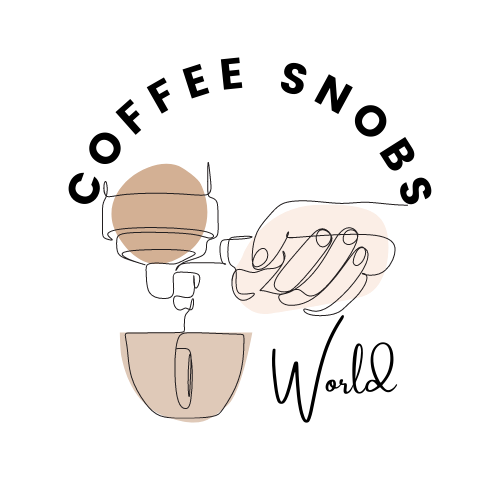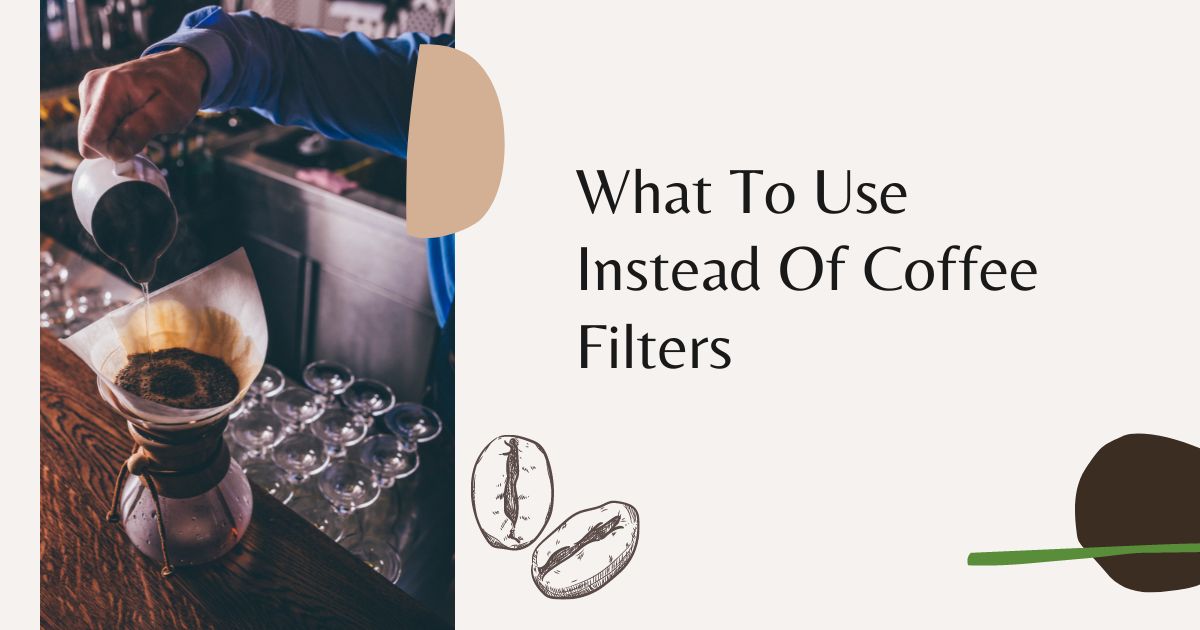What is a Coffee Filter?
Are you wondering what to use instead of a coffee filter? A filter that you can utilize for the process of brewing coffee is a coffee filter. Paper filters are disposable, while cloth, plastic, and metal filters are reusable.
Paper filters are for eliminating oily components known as diterpenes; these chemical compounds, found in unfiltered coffee, can reduce inflammation. Read on to learn more about filters and any other makeshift coffee filters.
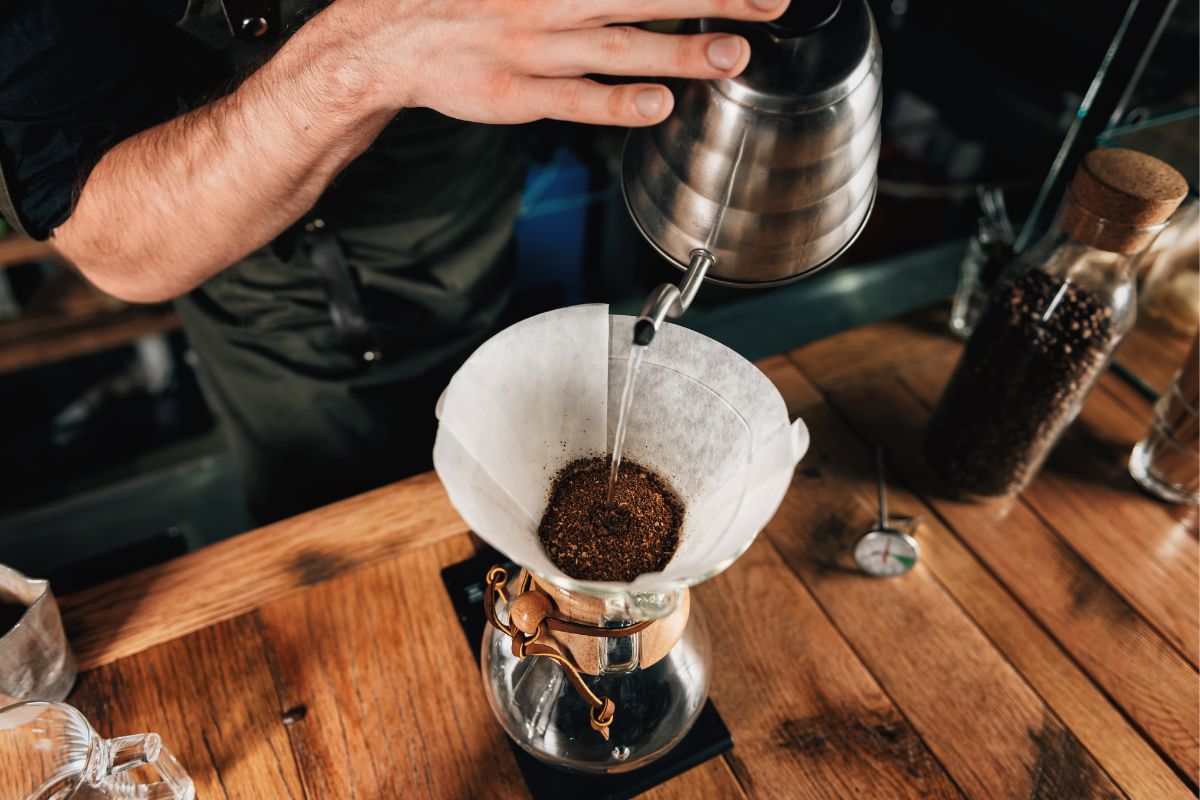
What to Use Instead of Coffee Filters
What can you use as a coffee filter? There are several things you can use as a coffee filter alternative. These may include:
Paper Towels & Napkins
The most typical method is to use a paper towel or a napkin as a coffee filter. Despite not being the intention of a coffee maker, these can have the same effect as a coffee filter, making them a great alternative.
Paper towels, however, may contain hazardous (and unpleasant) substances. Consider your next purchase of paper towels carefully, and consider sticking with the unbleached, brown version.
How to Use It
The steps are the same as when you regularly go about your morning routine. Place the napkins or paper towels where the filter typically goes before adding the grounds. You don’t want coffee grinds in your brew, so ensure you cover the entire compartment.
Pros
- Fine weave filters out grounds well
- It is inexpensive
- It is easy to use
Cons
- It is weak and may break
- It may contain taste-altering chemicals
Fine Mesh Sieves
If you frequently bake or cook, you must have a mesh sieve in your kitchen equipment. You can use this as a coffee filter as well. It makes a cup of coffee with excellent flavor and is very simple to operate.
How to Use It
Fill the bottom of a glass cup with the required amount of coffee. Give the grounds your prescribed amount of boiling water. After a single stir, this needs to steep for roughly five minutes. Pour the coffee through the fine-mesh sieve while holding it over a mug. The outcome? A strong cup of coffee!
Pros
- It produces an excellent taste
- It is easy to use
- It is environmental-friendly
Cons
- Less common
- It may not catch fine grounds
- It is harder to clean
Cloth Napkins or Dish Towels
You can also use a dish towel or cotton napkin as a filter if they are clean. Remember that coffee might stain, so pick a towel or napkin you’re not fond of.
How to Use It
Please place it in the space normally occupied by your coffee filter. As usual, add the grinds and let the water run through. Make sure to clean it afterward!
Pros
- Sturdy and inexpensive
- Trap even the finest grounds
- Environmentally-friendly
Cons
- Cloth may stain
- It may be too absorbent
- Can impart unwanted flavors
Reusable Tea Bags
You might have reusable tea bags or be able to make your own if you brew tea at home as frequently as you brew coffee. This alternative approach is the most inventive one on the list and functions fairly well.
How to Use It
Insert the teabag into the coffee grounds. Most of the time, two tablespoons or less is ideal. Then place the tea bag into a mug of hot water. All left to do is steep for four to five minutes or longer if you like your tea stronger.
If you don’t already have one, you can construct your own out of paper and twine. You should gently add coffee grinds after tying a paper in half the paper shut. A handcrafted tea bag has appeared!
Pros
- Steeping produces a strong flavor
- Easy to use
- Won’t leave grounds in your cup
Cons
- Less common and may be more expensive
No Filter at All
Utilizing a brewing technique that does not call for a filter is an additional choice. French presses with an integrated metal filter or percolator are two excellent choices.
How to Use It
Cowboy coffee (or its Norwegian counterpart Kokekaffe) is simple to prepare wherever you are if you don’t have a filter-free coffee maker. You only need a pot, water, coarse coffee grinds, and a heat source.
You can steep coffee by adding the grinds to boiling water. After then, turn off the heat and let the coffee cool as the grinds drop to the bottom of the pot. Fewer grounds may end up in your cup if you properly pour!
Pros
- You don’t need any substitutes
- Choice of brewing methods
Cons
- You may end up with grounds in your cup.
How to Make Coffee Without a Filter
It is no longer terrifying if you are without a drip coffee machine or a coffee filter. You can brew great coffee in your kitchen with various instruments, even without a coffee filter. When you’re in that circumstance, it might tempt you to filter it through a fine-mesh sieve using the cowboy approach.
The sieve keeps the grinds out of your coffee, while the immersion method yields a stronger cup. The reusable tea bags may be the ideal option for you if you want a less potent coffee. You receive a clear cup devoid of any residue. You can use a paper towel or dish towel instead of a tea bag if you don’t have any on hand. Here’s how to go about it:
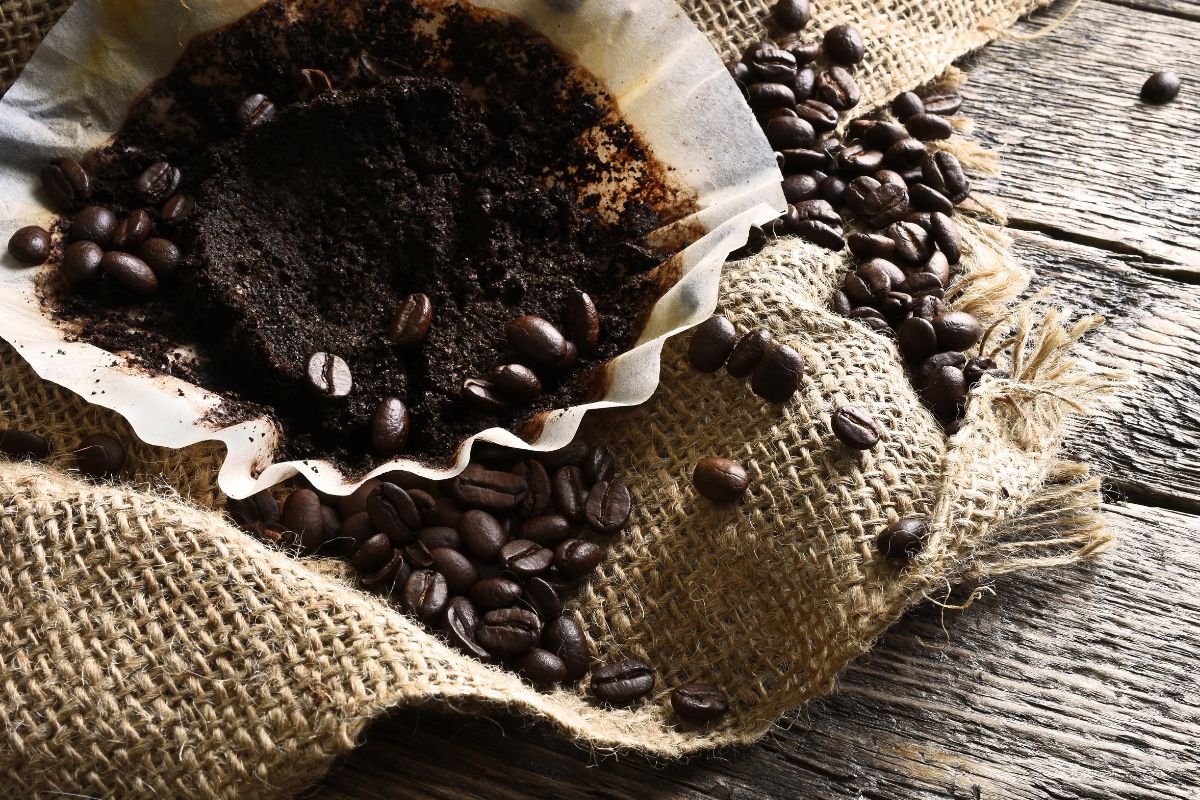
Cowboy Coffee
The simplest coffee-making method is “cowboy coffee” or “camping coffee.” This is how to traditionally brew coffee all around the world before the development of drip coffee makers. Additionally, this is what campers typically use around a campfire and what cowboys used to use while out on the range.
Heat the water in a metal pot and place it over a heat source. Then, after adding the ground coffee and stirring, you must wait a while until the grounds settle and the coffee brews. The hot coffee is then delicately poured into your cup. You don’t even use a filter. What are the drawbacks of this approach?
You’ll have some coffee grounds in your cup, making chewing on them as you drink your coffee a multi-sensory experience. Since neither paper nor fabric coffee filters can absorb coffee oils, the coffee will be rather strong.
This is a fantastic brewing technique for camping trips and when you must remember to pick up the filters at the store. It’s at the top of the list since it is an advisable filter-free coffee brewing.
Try a Filter Substitute
If chewy coffee is not your cup of tea, you could still be searching your kitchen (or other parts of your home) for a quick fix to make coffee without a filter. Many kitchen gadgets, some more efficient than others, can come in handy as a coffee filter replacement when you need them.
Paper Towel
Can you use a paper towel as a coffee filter? A paper towel might be the first coffee liner that comes to mind. After all, it does resemble a coffee filter in several ways. Will it function? Shortly after becoming wet, a normal paper towel starts to dissolve. This makes it a poor choice for a two or three-minute brewing time.
It is advisable to utilize the more robust, reusable paper towels because they are more durable than regular paper towels. They can withstand prolonged brewing. Alternatively, you may make your coffee using an immersion method, similar to the camping coffee as discussed above, and only strain it once with a paper towel at the end.
To accomplish this, spread your paper towel over a cup and somehow bind it to the rim. Rubber bands are the most reliable option. Once the hot coffee has been carefully poured through the filter and has gone through, remove the filter from the mug. This approach works well in a pinch.
Since it might be challenging to get the paper flavor out of paper towels, be ready for a residual taste. Depending on your paper towel, you can wind up with a weak brew rather than a flavorful cup of coffee, which could absorb practically all of the coffee oils. The absence of coffee grinds in your beverage is a plus.
Cheesecloth
Cheesecloth might also be present in your kitchen since you don’t have to worry about it dissolving in water. These directions apply to cloth napkins, dish towels, and butter muslin. You can use Cheesecloth, similar to paper towels. Pour the freshly brewed coffee over it after placing it in the mug and securing it so it doesn’t move throughout the filtering procedure.
The brew may be weak as the coffee oils and particles become entrapped in the cloth. You can get around this using finer grounds or a greater coffee-to-water ratio. You will not transfer the paper taste that paper towels leave behind to cheesecloths or other cooking cloths. However, the detergent you used to wash the fabric might taste good.
It’s a good idea to rinse well before brewing. You can make cold-brew coffee in this manner. To make cold-brew coffee, wrap your coffee grounds in Cheesecloth and let them steep overnight in room-temperature water. Remember that it will look different after you’ve brewed dark coffee in your towel.
Reusable Tea Bags
Coffee filters made from reusable tea bags are excellent. They are for steeping in hot liquid without disintegrating. Additionally, they won’t give the brew any unfavorable flavors. Remember that it’s similar to single-serve coffee pouches if using reused tea bags as a DIY coffee bag feels strange.
You’ll receive good results, they’re simple to use, and the brew won’t contain any ground coffee.
Add coffee to a tea bag before using it. 2 teaspoons of finely ground coffee are advisable. Put the bag in a mug, seal it, and then cover it with boiling water.
Remove the bag after two minutes of brewing. The drawback of this alternative to a coffee filter is that you might only sometimes have tea bags on hand in your kitchen. Additionally, they are somewhat pricey.
Socks
This is not a joke, despite what it might seem like. You can occasionally use fabric-covered socks as coffee filters. It is advisable to wear fresh socks. The “sock method” is a method of brewing coffee that is well-known worldwide. It is typical in Latin America.
But since it doesn’t produce the best or most reliable results, you won’t see it in any of our barista training sessions. What is the socks method exactly? It is a conical fabric suspended from a piece of wire or plastic and resembles a thin gym sock.
When pouring over, add ground coffee to the sock before adding water. It’s a straightforward drip brewing technique, and I’ve occasionally had good coffee using it. It’s a workaround that works in a pinch because most people have socks on hand. As previously mentioned, It is advisable wearing fresh socks that have yet to spend a lot of time inside your shoes.
If your sock is your best option, what should you do? You should position it over a tall glass and thoroughly rinse it with hot water. Since all the coffee oils will stay in the sock, choose a sock that isn’t too fuzzy.
After rinsing the sock:
- Discard the water.
- Fasten a rubber band around the rim of the glass to prevent the sock from falling in while the coffee is brewing.
- Add the hot water and ground coffee as if you were brewing in a V60.
Do your pouring techniques, or do you need to consider a gooseneck kettle? Most likely not; the fabric won’t support complexity or a remarkable body. You might be happy with the outcome, depending on the sock. Even though there won’t be any coffee grinds, this method will still produce better coffee than most others.
Mesh Strainer
If you don’t have a coffee filter handy, you can use a mesh strainer, like a tea strainer. After all, consider a standard French press. In essence, it functions as a filter using a type of mesh strainer.
The distinction is that a French press has a filter with an extremely fine mesh. You’re good to go if you have a filter with fine mesh. If not, be ready for your brew to contain a lot of grinds.
Use an immersion brewing system to prepare the coffee before using a mesh strainer to filter it.
Put the coffee grounds in a heat-resistant container large enough to hold the quantity of water you intend to use. That could be a whiskey glass, a measuring cup made of glass, or a coffee mug. When employing a filter, a coarse grind is preferable. After adding the hot water, wait for three to four minutes.
Stir, after that, carefully pour the brewed coffee through the mesh strainer onto your coffee mug or cup. Take a sip while tossing the coffee grounds. Depending on your filter, you might obtain a significant amount of ground coffee in the brew.
Since you won’t be using a paper filter, you can anticipate that all of the coffee oils will be present in the brew, giving it a rich body and flavor. This is also a fantastic alternative because a mesh strainer is a common kitchen appliance. You may have one in a drawer; it’s useful for straining the tea or small amounts of sauce.
Instant Coffee
Although this may sound unpleasant, you should only use it in emergencies. However, you can still make instant coffee without a filter or a coffee maker, so it falls under how to make coffee.
As you undoubtedly already know, this coffee does not require a coffee filter. You can brew the coffee beans, freeze, dry them, and then conveniently package them.
You make coffee by simply stirring hot water and coffee together. Paper filters are unnecessary because there are no coffee grinds to obstruct your enjoyment. Once opened, instant coffee can stay “fresh” for almost an eternity, so there’s no need to worry about wasting any flavor or aroma. Even though you won’t have the best coffee, that’s still convenient.
For some purists, drinking tap water is preferable to drinking instant coffee. Others claim that anything hot that makes them feel like drinking coffee will do in a pinch. You should keep a jar of instant coffee in the back of your cabinet for those times when you frequently forget to buy paper filters at the store.
What is the Purpose of a Coffee Filter?
A coffee filter serves the relatively straightforward purpose of holding the coffee grains and releasing the coffee so it can slowly drip into a coffee can, liberating unimaginable aromas. Simple, but the only way to truly appreciate your coffee as it should be. The coffee removes the harmful coffee oils (Cafestol and Kahweol), which can increase cholesterol levels.
According to studies, unlike with unfiltered or percolated coffee, when you filter coffee through filter paper, this oil stays in the filter for nearly 99% of the time. Diterpenes, oily coffee components, are captured by coffee filters during brewing. According to Harvard Health Publications, the two main diterpenes in coffee are cafestol and kahweol.
Coffee grounds floating in the coffee or oily droplets forming on the surface are two ways these oily substances get into your morning cup of joe. Additionally, these oily substances block an intestinal receptor controlling cholesterol when consumed.
Elevated blood cholesterol levels result from the intestines’ inability to properly control how much cholesterol you absorb and excrete due to this obstruction. Coffee filters significantly lower the risk of coffee-related cholesterol increases because they capture the compounds cafestol and kahweol.
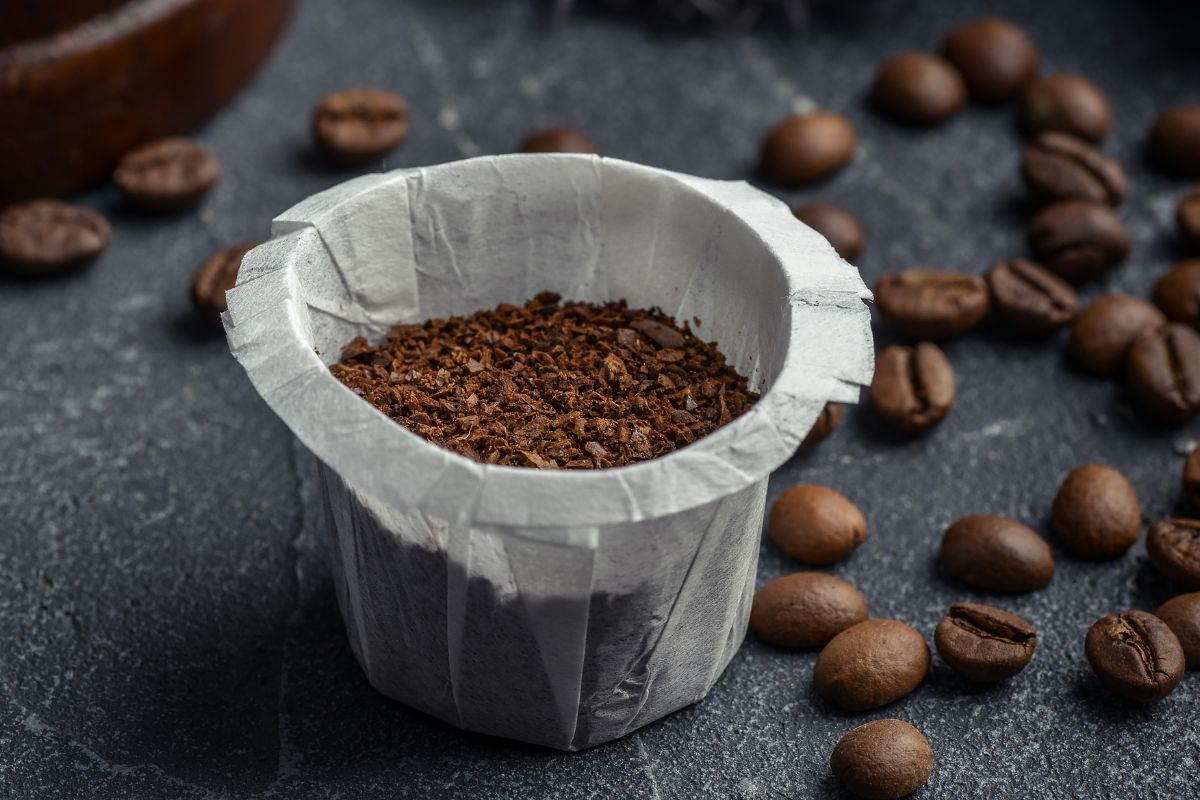
Parting Words
Depending on your coffee brewing method and flavor preferences, you can choose one of the three primary types of filters – paper, metal, and cloth. Paper filters can be your best bet if you want a clear cup of coffee with no hassle. Do you favor a reusable, robust filter that results in a stronger brew and a thicker mouth feel? Consider a metal filter.
Look into cloth filter options if you enjoy the taste and texture of paper-filtered coffee but want something more environmentally friendly. We hope this advice has assisted you in deciding which coffee filter will suit your needs the best. However, if you run out of coffee filters, you are now aware of several alternatives, and you can use any as an emergency coffee filter.
